Sweet Corn
European corn borer (ECB) moth catches remain very low, and concentrated primarily in Gloucester County (see map below at right). Most active infestations now are in pre-tassel stage corn, with whorl corn largely free of feeding as egg laying has declined. Feeding in scouted pre-tassel stage sweet corn ranges to above 30% in Hunterdon County.
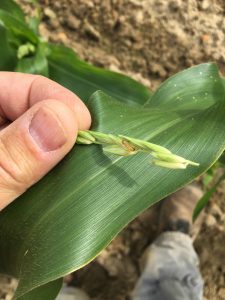
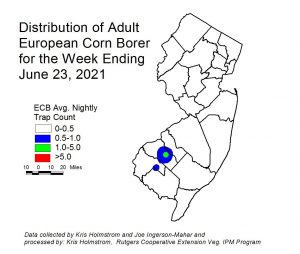 Look for the characteristic “shot-hole” type of feeding (photo below at right) and consider treating when infested plants exceed 12% in a 50 plant sample. As plantings proceed to the pre-tassel stage, ECB larvae may be found in emerging tassels (see photo at left). It is a good idea to treat individual plantings as they move into the full tassel/first silk stage one time. This eliminates any ECB larvae that have emerged with the tassels as they begin to move down the stalk to re-enter near developing ears.
Look for the characteristic “shot-hole” type of feeding (photo below at right) and consider treating when infested plants exceed 12% in a 50 plant sample. As plantings proceed to the pre-tassel stage, ECB larvae may be found in emerging tassels (see photo at left). It is a good idea to treat individual plantings as they move into the full tassel/first silk stage one time. This eliminates any ECB larvae that have emerged with the tassels as they begin to move down the stalk to re-enter near developing ears.
Useful insecticides for this particular application include synthetic 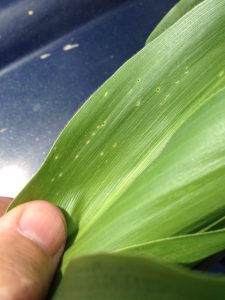 pyrethroids (IRAC Grp 3), spinosyns (including OMRI approved Entrust) IRAC Grp 5), and diamides such as Coragen or Vantacor (IRAC Grp 28) or materials such as Besiege which include the active ingredient in Coragen. Synthetic pyrethroids alone should NOT be used for corn earworm (CEW) protection on silking corn. Control with these materials is very inconsistent.
pyrethroids (IRAC Grp 3), spinosyns (including OMRI approved Entrust) IRAC Grp 5), and diamides such as Coragen or Vantacor (IRAC Grp 28) or materials such as Besiege which include the active ingredient in Coragen. Synthetic pyrethroids alone should NOT be used for corn earworm (CEW) protection on silking corn. Control with these materials is very inconsistent.
The highest nightly trap catches of ECB for the week ending 6/23/21 are as follows:
| Downer 2 | New Egypt 1 |
| Cinnaminson 1 | Old Bridge 1 |
| Medford 1 | South Branch 1 |
 Corn earworm (CEW) moths captures from blacklight traps have declined further, but continue to occur in a few locations. Pheromone trap captures have declined in most areas with the exception of traps in the southwestern portion of the state. Despite an overall decline, these traps are indicating a more conservative schedule in parts of the state. The number of pheromone traps deployed is much lower, resulting in much broader color bands on the map. It is also important to understand that pheromone traps are more sensitive than blacklight traps, and thresholds are adjusted to account for the higher catches typical of this trap type. Silking corn is at risk of CEW infestation at this time. On the blacklight map, green areas represent a 3-4 day silk spray schedule and blue represents a 4-5 day schedule. On the pheromone map, red represents a 3-day schedule and green represents a 4-5 day schedule. Be sure to access information from this publication in the upcoming weeks to determine how frequently you should treat silking sweet corn to protect it from CEW infestation.
Corn earworm (CEW) moths captures from blacklight traps have declined further, but continue to occur in a few locations. Pheromone trap captures have declined in most areas with the exception of traps in the southwestern portion of the state. Despite an overall decline, these traps are indicating a more conservative schedule in parts of the state. The number of pheromone traps deployed is much lower, resulting in much broader color bands on the map. It is also important to understand that pheromone traps are more sensitive than blacklight traps, and thresholds are adjusted to account for the higher catches typical of this trap type. Silking corn is at risk of CEW infestation at this time. On the blacklight map, green areas represent a 3-4 day silk spray schedule and blue represents a 4-5 day schedule. On the pheromone map, red represents a 3-day schedule and green represents a 4-5 day schedule. Be sure to access information from this publication in the upcoming weeks to determine how frequently you should treat silking sweet corn to protect it from CEW infestation.
The highest nightly blacklight trap catches of CEW for the week ending 6/23/21 are as follows:
| Matawan 2 | Georgetown 1 | Springdale 1 |
| Cinnaminson 1 | Long Valley 1 | Tabernacle 1 |
| Downer 1 | Sergeantsville 1 |
The highest nightly pheromone trap catches of CEW for the week ending 6/23/21 are as follows: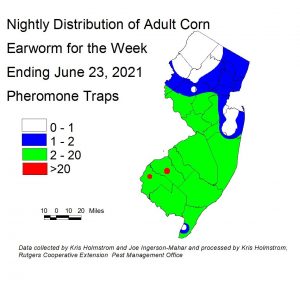
| Monroeville 36 | Tabernacle 11 | East Vineland 4 |
| Pedricktown 19 | Crosswicks 9 | South Branch 4 |
| Beckett 17 | Elm 8 | Berlin 3 |
| Woodstown 16 | Eldora 7 | Dayton 3 |
Silking Spray Schedules*:
South – 4 days
Central – 5 days
North – 6 days
*These recommendations are based on regional catches. Adhere to tighter spray schedules if indicated by local trap catches. Synthetic pyrethroids alone should NOT be used for corn earworm (CEW) protection on silking corn, or for fall armyworm (FAW) management at any stage. Control with these materials is very inconsistent. Utilize materials in IRAC groups 5 and 28, or combination products that include IRAC group 28 for best control. See the Sweet Corn section of the 2020-21 Commercial Vegetable Production Guide for selections.
Tomatoes

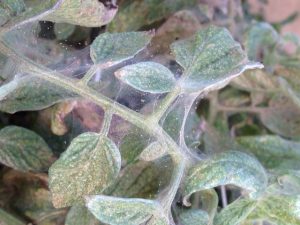 Two spotted spider mites (TSSM) have begun to appear in scouted NJ tomato fields. Signs of infestation include small, white “pin-spots” appearing on the upper surface of individual leaves (see photo at left). Mites will be feeding on the lower surface of leaves displaying these markings. If untreated, mite populations can increase dramatically, and may result in desiccation of foliage. Larger populations will produce webbing that encloses entire leaves (see photo at right). It is better to treat TSSM quickly after discovering them, as larger populations become harder to manage. There are a number of effective miticides listed in the Tomato Section of the 2020-21 Commercial Vegetable Production Guide, including some that have very short pre-harvest intervals.
Two spotted spider mites (TSSM) have begun to appear in scouted NJ tomato fields. Signs of infestation include small, white “pin-spots” appearing on the upper surface of individual leaves (see photo at left). Mites will be feeding on the lower surface of leaves displaying these markings. If untreated, mite populations can increase dramatically, and may result in desiccation of foliage. Larger populations will produce webbing that encloses entire leaves (see photo at right). It is better to treat TSSM quickly after discovering them, as larger populations become harder to manage. There are a number of effective miticides listed in the Tomato Section of the 2020-21 Commercial Vegetable Production Guide, including some that have very short pre-harvest intervals.
Peppers
 Phytophthora crown rot is hitting some fields following warm temperatures and high soil moisture. Look for clusters of wilting plants (photo at right). Inspect the stem near the soil line. If a black lesion is present, it
Phytophthora crown rot is hitting some fields following warm temperatures and high soil moisture. Look for clusters of wilting plants (photo at right). Inspect the stem near the soil line. If a black lesion is present, it 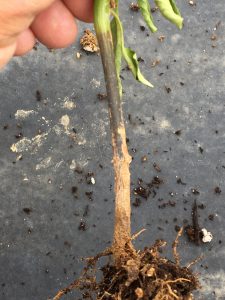 is likely that Phytophthora is responsible (photo at left). Please see Dr. Andy Wyenandt’s post of 5/30/21 regarding Phytophthora management.
is likely that Phytophthora is responsible (photo at left). Please see Dr. Andy Wyenandt’s post of 5/30/21 regarding Phytophthora management.
Pepper weevil – As yet, no weevils have been captured in pheromone traps, and we are not aware of any fields having infestations. A new fact sheet is now available for anyone interested in monitoring for pepper weevils on their own: FS1330: Monitoring and Management of Pepper Weevil in New Jersey (Rutgers NJAES).
Potato Leafhopper
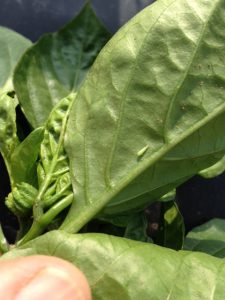 Potato leafhopper (PLH) adults (see photo at left) have appeared in snap beans and other crops over the past week. This pest is a particular problem because it often goes unnoticed until foliar distortion and burn occurs. Once this damage appears in beans and some potato varieties, yields have already been compromised. It is critical that beans be monitored regularly for the presence of PLH. If a sweep net is available, consider treating if more than 100 nymphs and adults are present in 20 sweeps of pre-bloom stage plants. This threshold increases to 250 during bloom and to 500 per 20 sweeps during pod development. If no sweep net is available, check plants in 10 random field locations and consider treating if adults and nymphs are found throughout. Adults are pale green, and will fly out from foliage when disturbed and immediately fly back into the plant canopy. Nymphs are wingless and bright green and may be found on the underside of leaves.
Potato leafhopper (PLH) adults (see photo at left) have appeared in snap beans and other crops over the past week. This pest is a particular problem because it often goes unnoticed until foliar distortion and burn occurs. Once this damage appears in beans and some potato varieties, yields have already been compromised. It is critical that beans be monitored regularly for the presence of PLH. If a sweep net is available, consider treating if more than 100 nymphs and adults are present in 20 sweeps of pre-bloom stage plants. This threshold increases to 250 during bloom and to 500 per 20 sweeps during pod development. If no sweep net is available, check plants in 10 random field locations and consider treating if adults and nymphs are found throughout. Adults are pale green, and will fly out from foliage when disturbed and immediately fly back into the plant canopy. Nymphs are wingless and bright green and may be found on the underside of leaves.
Cucurbit Downy Mildew
A cucurbit downy mildew (CDM) sentinel plot is now established at Snyder Farm in Hunterdon County. This plot, consisting of pumpkin, watermelon, cantaloupe, butternut, acorn, cucumber and kabocha squash will be used to indicate the presence of cucurbit downy mildew in the region, and what crops are affected. For regional information on this important disease, see the Cucurbit Downy Mildew Forecast webpage: http://cdm.ipmpipe.org/. Note that Dr. Andy Wyenandt has reported CDM on cucumbers (6/16/21) and cantaloupes (6/21/21) in Salem County NJ. Through Tuesday 6/22, the CDM Forecast had southern NJ counties at “High risk” for infection on these crops. It is advisable that all growers in southern counties treat preventively for CDM on these crops. Growers in norther counties should scout fields no less than twice a week. As yet, there have been no reports in the region of CDM affecting any other cucurbit crops. This is important, as pumpkins and winter squash are now emerging in recently planted fields.
Brown marmorated stink bug (BMSB)
BMSB trap catches remain very low. No map will appear in this addition.

